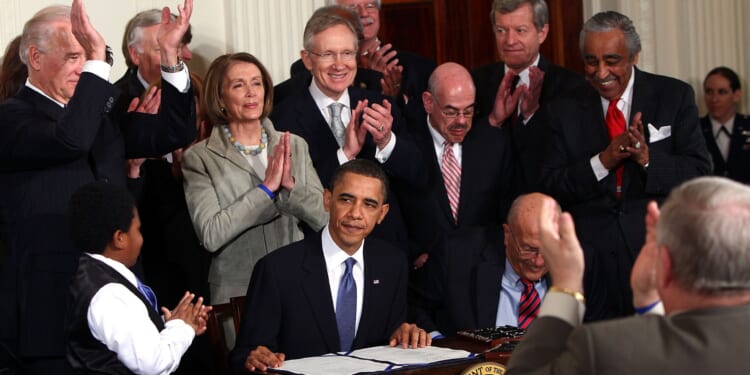A new round of Obamacare enrollment begins on Nov. 1 against the backdrop of an ongoing partial government shutdown that revolves around a debate over Democrats’ demands to expand the controversial 2010 law.
Then-President Barack Obama and other Democrats made numerous promises about the Affordable Care Act, better known as Obamacare.
The following are four broken promises from the Obamacare law.
1. ‘Your Premiums Will Go Down’
In July 2012, when campaigning for reelection, Obama repeated his assertion that—once implemented—the Affordable Care Act would reduce prices.
Running for his first term in 2008, then-Sen. Obama said he would sign a health care bill in his first term as president “that will cover every American and cut the cost of a typical family’s premium by up to $2,500 a year.”
In 2012, he spoke similarly about the law that had passed—with no Republican votes in Congress—but had not yet gone into effect.
“You should know that once we have fully implemented, you’re going to be able to buy insurance through a pool so that you can get the same good rates as a group that if you’re an employee at a big company you can get right now, which means your premiums will go down,” Obama said, when speaking in Cincinnati campaigning for a second term.
In 2013, when implementation of the Affordable Care Act began, the average premium paid by consumers in the individual market was $244 per month. By 2022, that cost had soared to $568 per month, an increase of 133%, noted a Heritage Foundation report from August 2024, “Key Health Care Trends: Nationally and in Each of the States.”
“The average deductibles for bronze-level plans sold on the exchanges increased by 40 percent between 2014 and 2024,” the Heritage report explains. “For self-only coverage, the average deductible was $5,094 in 2014, but is $7,144 in 2024, while the average deductible for family coverage has increased from $10,278 in 2014 to $14,310 in 2024.”
In recent years, 15 states have obtained federal waivers from some Obamacare provisions, which enabled insurers in the waivered states to reduce premiums.
The per-capita average monthly cost of individual market coverage had more than doubled in 40 states. In Missouri, costs had risen by 213%; in Alabama, by 309%; and in West Virginia, up 323%, according to the August 2024 Heritage Foundation report.
2. ‘Competition Where There Wasn’t Competition’
Obama asserted in October 2013 that the Affordable Care Act would create a more competitive insurance marketplace.
“What we’ve done is essentially create a competition where there wasn’t competition before,” Obama said. “We created these big group plans, and now insurers are really interested in getting your business. And so, insurers have created new health care plans with more choices to be made available through these marketplaces.”
But two-thirds of states, or 34 states, and the District of Columbia had fewer insurers offering exchange coverage in 2024 than a decade earlier, before the Affordable Care Act was implemented.
On the slight upside, eight states had more insurers offering plans on the Healthcare.gov exchanges in 2024 than they had before the Obamacare law was passed, while eight others have the same number.
For 2026, some 183 qualified health plans are available on the Obamacare exchanges, the Centers for Medicare and Medicaid Services announced Wednesday. Of the 30 states using HealthCare.gov, 19 have more plans than the previous year, according to CMS.
That’s still substantially less than before Obamacare was implemented. In 2013, almost 400 insurers were offering coverage in individual markets at the state level before the ACA was implemented. Eight states had only one insurer providing insurance.
In 2026, 95% of enrollees will have access to three or more qualified health plan issuers. That’s down marginally from 96% in 2025, but an improvement from 68% in 2020, according to CMS. Fewer than 1% of 2026 enrollees have only one available issuer on the exchanges.
“Any potential benefits of competition were offset, or more than offset, by a subsidy design that really insulates enrollees from a lot of the cost, because the subsidies go up as premiums go up. That’s part of why you have seen the increase,” Ed Haislmaier, a senior research fellow with the DeVos Center for Human Flourishing at The Heritage Foundation, told The Daily Signal.
3. Not ‘One Dime to Our Deficits’
Obama said in September 2009, “I will not sign a plan that adds one dime to our deficits, either now or in the future.”
The initial score by the Congressional Budget Office in 2010 estimated the legislation would reduce the federal deficit. However, the cost of Medicaid expansion was higher than projected, as was the cost of subsidies, which was exacerbated by the COVID-19 pandemic.
The expansion of the COVID-19 era subsidies was passed as part of the 2021 American Rescue Plan Act and extended as part of the 2022 Inflation Reduction Act. The COVID-19 emergency formally ended two-and-a-half years ago.
The CBO found in 2024 that extending the COVID-19-era subsidies permanently would result in a $380 billion cost increase to taxpayers over the next 10 years. It would also likely mean 6.9 million individuals would be added to the Obamacare exchanges—receiving an average subsidy of $5,370 each. But of that 6.9 million, at least 3.5 million would be shifting from existing insurance plans such as employer plans, according to CBO.
Before the COVID-19 subsidies, Obamacare enrollment was stable. In 2019, 13.7 million individuals drew a subsidy. By just the first quarter of 2025, that reached 26.7 million—nearly double.
“Obamacare is not affordable, and has narrowed network plans to exclude certain doctors and hospitals,” Brian Blase, president of Paragon Health Institute, a health care think tank, told The Daily Signal. “The only people purchasing are, for the most part, getting giant subsidies. It’s good for the health insurance companies. There used to be a guaranteed customer base with the individual mandate, which was eliminated. But it’s still a heavily regulated market, which decreases competition, and they receive massive subsidies.”
4. ‘Savings’ From Medicaid Expansion
“The insurance reforms rest on everybody having access to coverage, and you also don’t do anything about the fact that taxpayers currently end up subsidizing the uninsured when they’re forced to go to the emergency room for care, to the tune of about a thousand bucks per family,” Obama said in March 2010. “You can’t get those savings if those people are still going to the emergency room.”
Almost 20 million newly eligible able-bodied adults enrolled in Medicaid from 2013 to 2023. That’s compared with Medicaid enrollment for children that increased by just 2.5 million, and for the elderly that increased by 1.2 million over the same 10-year span. The number of disabled enrollees over that period declined by 400,000, the Heritage Foundation report from August 2024 says.
Emergency room visits from the new Medicaid enrollees have increased, the Paragon Health Institute noted in a report last October.
“As a result of expansion, existing Medicaid enrollees have had more challenges obtaining doctor appointments,” the Paragon report says. “According to a 2019 meta-analysis, prior to expansion, Medicaid enrollees were half as likely as those with private insurance to get appointments, while they were only one-third as likely after expansion—a decline by one-third.”
From 2013 to 2023, Medicaid enrollment, as well as enrollment in the Children’s Health Insurance Program, soared overall from 61.1 million to 85.4 million.
Medicaid enrollment more than doubled over those 10 years in Alaska, Virginia, Oregon, and Nevada.

















